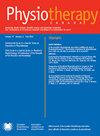物理治疗师对脑卒中康复干预措施的认识和应用
IF 0.8
4区 医学
Q4 REHABILITATION
引用次数: 0
摘要
这项研究收集了加拿大PT样本中目前对中风康复干预措施的认识和使用情况的数据,作为未来努力将康复研究文献转化为实践的基础性步骤。参与者来自为加拿大10个省的患者提供中风康复服务的医疗保健中心。为中风后的个人提供直接康复护理的物理治疗师,年龄在18岁以上,能够用英语读写,完成了一项电子调查。关于治疗师的工作环境、患者人口统计、他们如何保持最新状态以及他们对中风康复干预的认识和使用的问题。175人(女性=82.9%)主要来自安大略省和阿尔伯塔省(57.7%)。治疗师对非技术性、外围应用的干预措施(如特定任务训练、躯干训练、地上行走)有很高的认识和使用率。除了镜像治疗和双侧手臂训练外,治疗师对有或没有技术成分的大脑启动干预措施的认识和使用程度较低或根本没有。治疗师对标准教育和培训之外的干预措施的认识和使用程度较低。这是未来研究如何将知识转化和实施到临床实践中的一个重要领域。本文章由计算机程序翻译,如有差异,请以英文原文为准。
Awareness and Use of Stroke Rehabilitation Interventions in Clinical Practice Among Physiotherapists
This study collected data about the current awareness and use of stroke rehabilitation interventions among a Canadian sample of PTs as a foundational step towards future endeavours to inform the translation of rehabilitation research literature into practice. Participants were recruited from health care centres providing stroke rehabilitation to patients in each of the 10 provinces across Canada. Physiotherapists who provided direct rehabilitative care to individuals after a stroke, were 18+ years old, and could read and write in English completed an electronic survey. Questions asked about therapists’ work setting, patient demographics, how they stay up-to-date, and their awareness and use of stroke rehabilitation interventions. One hundred seventy five individuals (female = 82.9%) mainly from Ontario and Alberta (57.7%) were included. Therapists had high awareness and use of non-technological, peripherally-applied interventions (e.g., task-specific training, trunk training, overground walking). Except for mirror therapy and bilateral arm training, therapists had low or no awareness and use of brain priming interventions with or without a technological component. Therapists had low awareness and use of interventions which fall outside of standard education and training. This is an important area for future research on initiatives to increase knowledge translation and implementation into clinical practice.
求助全文
通过发布文献求助,成功后即可免费获取论文全文。
去求助
来源期刊

Physiotherapy Canada
REHABILITATION-
CiteScore
1.90
自引率
20.00%
发文量
93
审稿时长
>12 weeks
期刊介绍:
Physiotherapy Canada is the official, scholarly, refereed journal of the Canadian Physiotherapy Association (CPA), giving direction to excellence in clinical science and reasoning, knowledge translation, therapeutic skills and patient-centred care.
Founded in 1923, Physiotherapy Canada meets the diverse needs of national and international readers and serves as a key repository of inquiries, evidence and advances in the practice of physiotherapy.
Physiotherapy Canada publishes the results of qualitative and quantitative research including systematic reviews, meta analyses, meta syntheses, public/health policy research, clinical practice guidelines, and case reports. Key messages, clinical commentaries, brief reports and book reviews support knowledge translation to clinical practice.
In addition to delivering authoritative, original scientific articles and reports of significant clinical studies, Physiotherapy Canada’s editorials and abstracts are presented in both English and French, expanding the journal’s reach nationally and internationally. Key messages form an integral part of each research article, providing a succinct summary for readers of all levels. This approach also allows readers to quickly get a feel for ‘what is already known’ and ‘what this study adds to’ the subject.
Clinician’s commentaries for key articles assist in bridging research and practice by discussing the article’s impact at the clinical level. The journal also features special themed series which bring readers up to date research supporting evidence-informed practice.
The Canadian Physiotherapy Association (CPA) is the national professional association representing almost 15,000 members distributed throughout all provinces and territories. CPA’s mission is to provide leadership and direction to the physiotherapy profession, foster excellence in practice, education and research, and promote high standards of health in Canada.
 求助内容:
求助内容: 应助结果提醒方式:
应助结果提醒方式:


